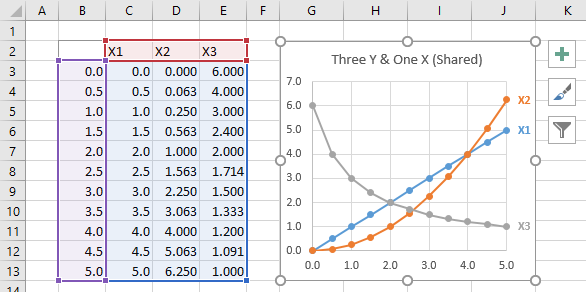
- Dynamic xy scatter chart excel how to#
- Dynamic xy scatter chart excel series#
In Data Source table, vlookup up “Order” from “Mapping Table”, we are going to use this Order value as x-axis value instead of using Grade. To group Grade text (ordinal data), prepare two tables:Ģ) a mapping table indicating the desired order in X-axis Solution – Excel scatter chart using text name Therefore in the below scattered chart, we see 10 data points. If we put text name in x axis (Grade), in order to force text name to become numeric, Excel converts first x value (Grade 1) to numeric value 1, the 2nd x value (Grade 3) to numeric value 2, and so on. Sometimes we categorize x axis values as a group name (ordinal data) instead of providing the actual numeric value. From the graph, you can see the trend that Salary increases exponentially with Grade (although the data is dummy, the trend is real). Excel scatter chart using text nameĮxcel scatter chart requires the x axis and y axis for each data point to be plotted in a diagram, and then join all those point together to analyze the trend or analyze if x and y variables are correlated, where X and Y values have to be numeric values.īelow is an example showing how employee Grade is related to salary.
Dynamic xy scatter chart excel how to#
I wrapped all formulas in IFERROR so that I don’t get error popups.This Excel tutorial explains how to ordinal data (text) in scatter chart using bar chart. I could have gone farther of course, I just got bored. Some fields will overshoot that 5000th row. I only copied the formulas down to row 5000, and set my named ranges to cap out at row 5000 as well. You must also perform the happy Excel dance in order to appease the ancient lords of recalc Also note that you must prepend the name of the workbook, then a “!”, to your names in orderĬ. 
Note that I’ve already done that in the picture aboveī. Then you edit that formula, replacing any range of cells with your dynamic named ranges, XRange and YRangeĪ.
Dynamic xy scatter chart excel series#
If you do this right, your data points will get selection handles and the SERIES formula will appear in the formula bar, like this:ģ.
Now, in the created chart, select the data range within the chart. Point it at whatever data you currently have, as if it was going to be a static chart (yes, use the refedit control for now) What you put in here will NOT adjust, ever. This is the chart refedit control, for reference. The reason is, that refedit control will eat your dynamic named range and convert it into a fixed range, destroying all of that incredibly obscure work you did above J Second is this: YOU MUST NOT RELY ON THE REFEDIT CONTROL TO POINT YOUR CHART AT YOUR DATA The formula I used for YRange is simply another offset off of that first named range (XRange), using this formula: Here is that formula in case you want to copy paste it: Since each column has a different distinct number of members, you’ll get behavior that is essentially the same as more/less data after a refresh.įirst is defining named ranges that refer to an OFFSET formula rather than a fixed range: To simulate the effect of getting more/less data, modify the Set in cell A1 to grab any column out of that you’d like. OK, you have the workbook now, right? Let us continue. It will be easiest if you follow along on your own desktop, so PLEASE GRAB THE WORKBOOK FROM HERE – that contains the results of everything I show below. But why complain? Fact is, it CAN be done, and it feels like magic. You’re gonna use that CUBESET function, and you’re gonna like it!īut you might have a love/hate reaction to some of the other Excel acrobatics I am about to share :) For something that Excel actually supports natively, and seems to have gone out of its way to support, this should be easier to do than it is. Intrepid PowerPivot adventurers, however, may want to try out the following technique, by which the data WILL be picked up in your chart. The answer is “no, not even close.” :) When you convert to formulas, the original list of rows/columns is fixed, by virtue of the CUBEMEMBER function that makes up the axes. 
But tomorrow, I may have a different number of data points.

The next question is usually “OK great I can scatter chart my data points. Once it’s converted to formulas, you can create any chart type you want against it, no restrictions. Remember the post where I converted a PivotTable to Cube Formulas using that button on the ribbon? This is a wonderful opportunity to use that feature in an unexpected way. Try to use XY (Scatter), Bubble, or Stock as a PivotChart, and you’ll get the alert below: But not all of them are supported as PivotCharts. This was going around on the MS-internal discussion list this past weekend:Īt right is a list of all chart types in Excel.







 0 kommentar(er)
0 kommentar(er)
